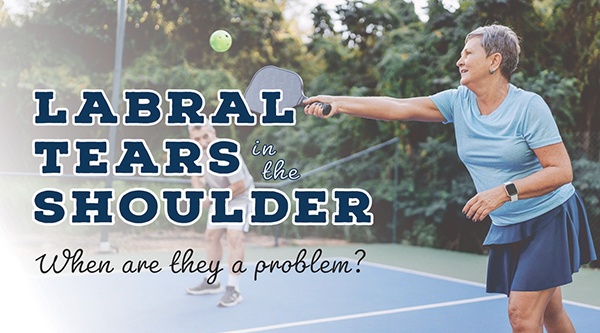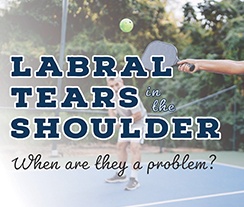
That off-and-on pain in your shoulder has been getting worse, and lately it’s been waking you up at night. In fact, you can’t sleep on your side anymore because your shoulder hurts too much. You don’t remember hurting your shoulder, but this pain isn’t normal for you—something is definitely wrong. Could it be a labral tear?
What is a Labrum?
Unless you or someone you know has injured theirs, a labrum might be something you’ve never heard of before. The labrum is a thick band of soft tissue (cartilage) that surrounds and helps stabilize the “ball-and-socket” joints found in the hips and shoulders. It allows those joints to glide smoothly in multiple directions without dislocating. However, when a tear occurs in the labrum, that smooth motion gets interrupted resulting in pain and reduced range-of-motion. The effects of a torn labrum can range from a nagging ache to partial or complete joint dislocation.
Shoulder labral tears aren’t always caused by an accident or sudden injury. Overuse of the shoulder joint, especially repetitive overhead motions, as well as daily wear and tear are other common causes. Damage from wear and tear is more likely after age 40, because cartilage becomes more brittle as we age. A torn labrum will not grow back like skin does.
Signs that You Might Have a Torn Labrum
The following shoulder labral tear symptoms are the most common, although they will vary depending on the type and location of the labral tear.
- Pain
- Instability
- Feelings of grinding, locking, or catching when moving the shoulder
- Inability to perform normal shoulder movements
Types of Labral Tears
The two most common types of injuries to the labrum are SLAP (superior labrum from anterior to posterior) tears and Bankart tears.
SLAP: SLAP tears occur at the front of the upper arm, which is where the biceps tendon attaches to the shoulder. Quick throwing or overhead motions can cause SLAP tears, and the pain is felt in the front of the shoulder near the biceps tendon.
Bankart: Bankart tears are seen mainly in the lower part of the labrum of younger patients who dislocated their shoulders. Bankart tears can cause the head of the humerus (the “ball” at top of the arm bone) to slip out of the socket more easily.
Treatment Options
Treatment for labral tears varies depending on the severity of the tear (or tears), the location of the tear, patient age, and patient activity level. The most appropriate treatment plan can be provided only after knowing the location and severity of the tear, which is why it’s important to visit a physician who specializes in treating shoulder injuries. Patient age and activity level will influence the type of treatment provided. For some people, rest and physical therapy will resolve the issue, but for others surgery may be the best option.

